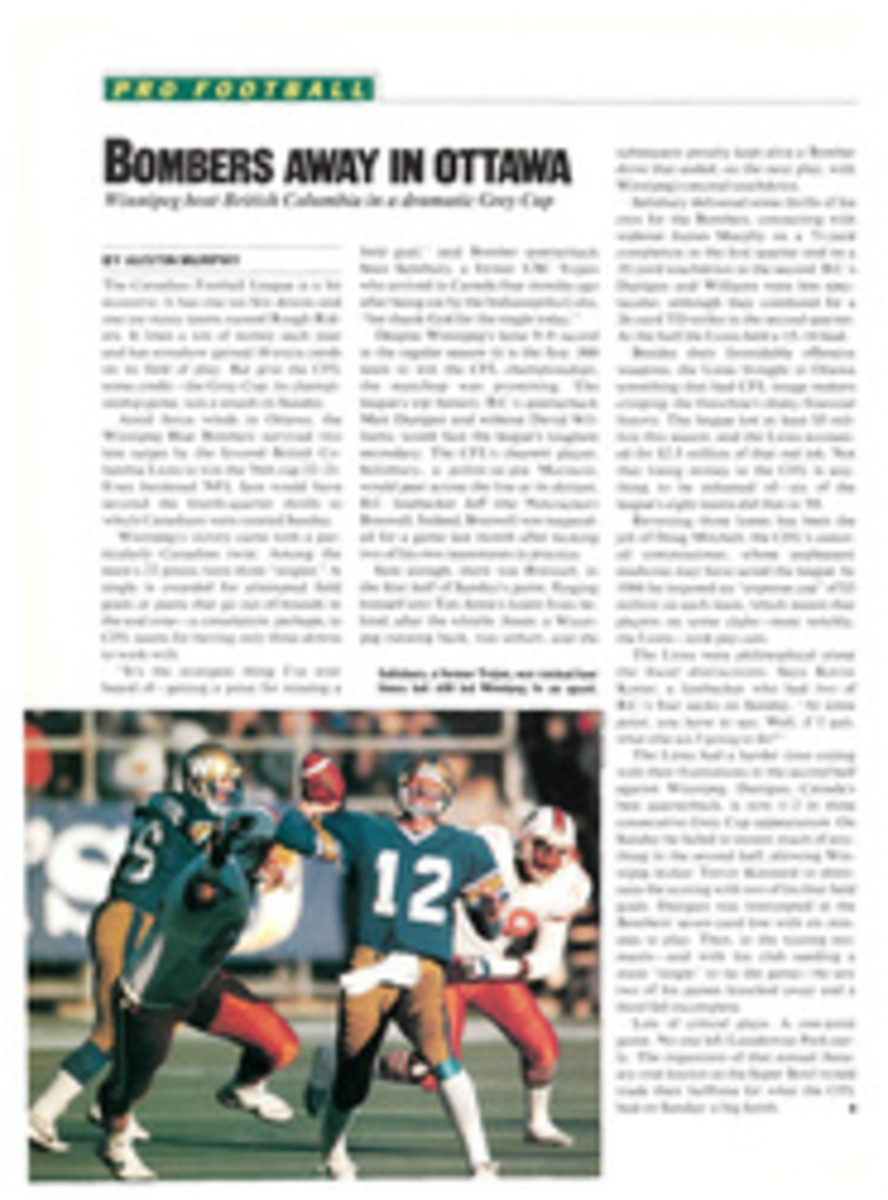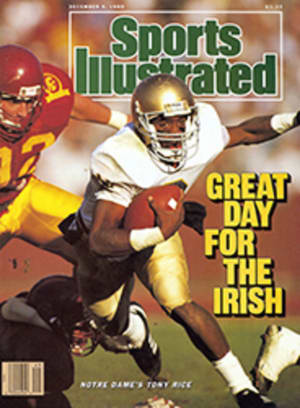
STRIKING A POSE FOR POSTERITY
There's a Heisman Trophy in Ed Smith's den, but it's not there for the same reason that other Heismans are in other dens. Smith, 75, a former NYU fullback who now lives in Lynbrook, N.Y., didn't win the trophy; he is the trophy. On Dec. 8, New York City's Downtown Athletic Club will present the nation's outstanding college football player with a bronze likeness of Smith, who modeled for the statue back in 1934—but didn't find out what he had posed for until 48 years later.
Smith ran, passed and often quick-kicked in NYU's single-wing offense during the 1933-35 seasons. At 6'2" and 210 pounds, he was a big, bruising runner, a rare breed at the time. "You needed a triple-threat back in those days, and that was me," he says.
In 1934, Smith and the Violets floundered through a 3-4-1 season, due in part to Smith's having been disabled by a torn ligament in his left leg and a hemorrhage in his right leg. Meanwhile, the Downtown Athletic Club was making plans to launch an annual award recognizing the best college football player east of the Mississippi. The DAC wanted its award to be something special. The four members of its Club Trophy Committee—chairman Willard B. Prince, founder and editor of the DAC journal; coaches Jim Crowley of Fordham (he had been one of Notre Dame's legendary Four Horsemen) and Lou Little of Columbia; and John Heisman, who had finished his illustrious coaching career at Rice University seven years earlier and who now served as the DAC's first athletic director—weren't interested in an ordinary bowl or cup. Instead, the DAC approached a young sculptor named Frank Eliscu, whose work had been exhibited at the National Academy of Design in New York City. Would he create an original trophy for the DAC? Eliscu was happy to take on a commissioned work, especially because this was during the Depression, and the DAC offered him $500 for the project.
Eliscu began by making a handful of small wax figures to be used as "sketches," and he then suggested that the trophy committee members choose one they liked. Two of the figures depicted one player tackling another. A third was the figure of a runner with a ball tucked under his left arm and his right arm extended in front of him. The committee members liked the runner, but it seemed to them that if he were fending off tacklers, he would be more likely to have his arm out to the side than to the front. They asked Eliscu to make the change, and he headed back to his Greenwich Village studio to transform sketch into statue.
In need of a model to make the figure lifelike, Eliscu thought of his friend Ed Smith, whom he'd known since their boyhood days in Manhattan's Washington Heights section. They had both attended George Washington High School, where Eliscu was a sprinter on the track team and Smith starred on the football team. Eliscu knew that Smith was playing for the Violets and asked him to pose in his uniform at the studio. Smith agreed.
Wearing the leather helmet, canvas pants and hightop shoes of the day, his left arm cradling a ball and his right arm out straight to the side, Smith modeled several times. They never discussed exactly what Eliscu was working on. "I figured he wanted it for himself," Smith recalls. "He never told me what it was for, and I never asked." Eliscu didn't volunteer the information because, aside from the money, the project wasn't that big a deal. "Back then it was just a trophy for the Downtown Athletic Club," says Eliscu, who is now 76 and lives in Sarasota, Fla. "And you don't usually tell a model what he's posing for."
A month after Smith's sessions with Eliscu, the sculptor finished the figure in clay. Then Crowley, a stickler for authenticity, took the prototype out to Fordham's Rose Hill field and had one of his players, halfback Warren Mulrey, mimic the statue's pose while Eliscu watched. Back in the studio, Eliscu executed a few final alterations and then made a plaster cast, which was sent to a foundry for bronze casting. The finished statue—like each one that followed it—was 14 inches long and 13½ inches wide, and it weighed 25 pounds.
In December 1935 the first Downtown Athletic Club Trophy was given to halfback Jay Berwanger of the University of Chicago. Heisman died the following fall, and the award was renamed the Heisman Memorial Trophy before its second presentation, which was to end Larry Kelley of Yale in '36.
Long before the award grew to national prominence (the first award was the only one that specified the player had to be from east of the Mississippi), Smith and Eliscu lost touch, and Smith remained unaware of his role as a footnote to college football history. After graduating from NYU in the spring of 1936, he played in the NFL for the Boston Redskins that fall and the Green Bay Packers for part of the 1937 season, until a flare-up of his ligament injury forced him to quit pro ball. He recovered enough to finish the 1937 season with the semipro Newark Bears. In 1941, Smith made a comeback with another semipro team, in Springfield, Mass., which featured a young lineman named Vince Lombardi. But Smith didn't last long. He went into the elevator-construction business, retiring in 1976.
Eliscu, meanwhile, joined the Army during World War II and afterward left Manhattan for Ossining, N.Y. He gained national renown as a sculptor, completing, among other works, the large bronze A Cascade of Books over the doors of the Library of Congress James Madison Memorial Building.
In the fall of 1982, filmmaker Bud Greenspan was preparing to produce the television coverage of the Heisman Trophy award ceremony that December. Greenspan decided it would be fun to find the model and invite him to the Heisman dinner. Greenspan's publicity man, Joe Goldstein, learned that a man named Ed Smith was the model, but finding the right Ed Smith was a little trickier. Fortunately, one of Goldstein's friends knew that the Ed Smith was the brother-in-law of Bob Pastor, a former heavyweight boxer who fought (and lost to) Joe Louis twice. Pastor put Goldstein in touch with Smith.
When Goldstein finally got Smith on the phone, he said, "So you're the guy who modeled for the Heisman Trophy!" assuming that Smith was aware of what he and Eliscu had collaborated on. Smith had no idea what Goldstein was talking about, and Goldstein was momentarily confused. Was he talking to the Ed Smith who used to play for NYU? Yes, Smith assured him. Had he ever known a Frank Eliscu? Sure, said Smith; Frank was an old friend. Had Smith ever modeled for him? Yes, once in his studio, in a football uniform. Had Smith ever seen the Heisman Trophy? Of course. Who hadn't?
"At first I thought it was some kind of crank call," says Smith. "Then what he was saying sank in. I couldn't believe it. It almost threw me off my feet."
A few weeks later, at the Heisman award dinner, Smith got his first look at Eliscu's original bronze statue, which is on permanent display in the DAC lobby. The DAC presented him with a Heisman of his own in 1985.
And yes, Smith says, the little bronze running back is an excellent likeness—although he doesn't necessarily think that's a good thing. In 1986, Smith took part in the televised award ceremony during which Vinny Testaverde of Miami was presented with the Heisman. Before the winner was announced, Smith was introduced, and he turned to four of the leading contenders—Testaverde, Paul Palmer of Temple, Brian Bosworth of Oklahoma and Gordon Lockbaum of Holy Cross—and said, "Whoever wins the award, I feel sorry for you, because you're going to be looking at my ugly face for a long time." Not one of them would have minded.
PHOTO
MICHAEL BAILEY
Smith proved more famous as a model than as a player.
PHOTO
COURTESY ED SMITH
At NYU, Smith was the epitome of the triple-threat player.
Author Jim Harmon is not related to 1940 Heisman winner Tom Harmon.

